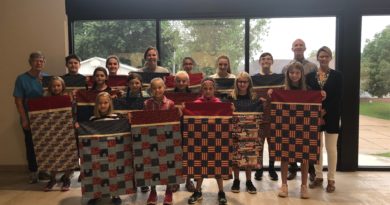Pressure from wind developers warrants investigation
Nebraska Extension urges landowners to seek help
Thayer County and other Nebraska landowners are being approached to sign long term contracts to sell wind rights on their land. A growing number of farmers and landowners are being approached to sell wind rights in Nebraska says John Hay, University of Nebraska Extension Educator in Bioenergy. Nebraska is one of the top five states for undeveloped wind energy potential and wind developers are coming to this county.
Thayer County commissioners expressed concern at their regular meeting, Jan. 26, about pressure from wind developers being felt by landowners in the southern part of county. “Some landowners in Byron and Chester area are getting hassled about signing agreements for wind development,” said commission chairman Dave Bruning. “I want to put a warning out that they need to be aware of what they are signing or at least get an attorney to look over any contracts.”
Extension Educator Randy Pryor recommends that landowners read the Iowa State University publication “Wind Energy Production, Legal Issues and Related Liability Concerns for Landowners” by Dr. Roger A. McEowen. Based on Dr. McEowens experiences in the Midwest, wind energy agreements are drafted in favor of the wind energy company. Those contracts require negotiation and modification on several provisions to make them an equitable agreement from the landowner’s perspective. The publication can be found at http://www.calt.iastate.edu/briefs.
“At first it’s only human nature to have that “gold rush” mentality with these offers,” Pryor said. “Once signed, the wind contracts are binding to the landowner. It’s really a family matter because these agreements, if executed, could last for 20 to 40 years.”
It’s crucial landowners work together and agree NOT to sign without experienced legal advice, Pryor added. “This actually helps the private wind developer rather than being detrimental. Land leases need to be in a contiguous area with the same company and if landowners agree to work together, it actually helps the developer. With landowners working together, the chance of a project can increase.”
In Saline County, after negotiation, an agreement was signed by the landowners with a private company in 2008; however, with no buyer to purchase the wind power, nothing has happened for two years Pryor explained. “We are a public power state and last year 34 new wind energy proposals were received by NPPD and all were shelved last August.”
NPPD and OPPD continue their plans to meet a goal of 10 percent wind energy by 2020. President Obama announced a new goal in his state of the union address to have one million electric vehicles on the road within four years and clean power sources providing 80 percent of the nation’s energy by 2035.
“The bottom line is landowners have time to study the wind energy leases and ask questions,” Pryor said.
UNL Extension offers landowner educational programs on the key issues. If you are being pressured to sign by a developer, that may be an indicator of a company that you do not want to do business with. If your wind resource is there, and transmission ability is there, and willingness of neighboring landowners are agreeable, then the ability to sign contracts will be there tomorrow too.
University of Nebraska Extension has assembled an outstanding educational resource for Nebraska landowners. For more landowner wind energy information, go to the UNL Extension website at: http://bioenergy.unl.edu.


